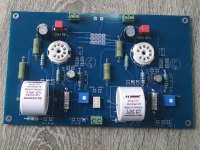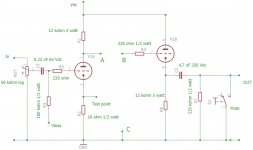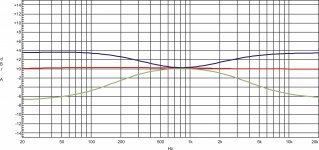Would it be acceptable to drive a Baxandall passive/active tone stack via a 6DJ8? I have mostly finalized a headphone amp design that is driving 6GC5 SE pentodes via a 6DJ8 (1/2) per channel, and have enough physical space and current headroom on the PSU to add another tube to the design. I've got several other 6DJ8's and Soviet 6N23P's on hand, and would like to use one to drive a tone stack in-between the preamp and power amp section, if that would be an appropriate tube to use for that. I've mainly seen high mu triodes like the 12AX7 used in that role, however. B+ here is 240v. It makes more than enough gain as is, but I'd like to keep that headroom in case I want to turn the volume up on particularly quiet tracks. Worth doing or would I be better suited to use a high mu triode?
The Bax is an active design; that was the core of Peter Baxandall's invention. What are you really building?Baxandall passive/active
The classic Bax active tone network gives about 20dB (10:1) extreme boost. For few-dB accuracy you need another 10:1 of excess gain to put into NFB. Peter used a high-slope pentode. Fisher et al et al and et al wouldn't spend the extra buck, used the 12AX7 because that's the most gain you can get in a twin-tube. The gain is rarely 50 so the 5:1 of excess gain promises ~~20% or 2dB error, which is tolerable for home tone boosting.
Note that most tone networks need a buffer before. A Bax on 100k pots will sink to 10K input impedance at an extreme which is heavy load on low-cost tube systems. 1Meg pots were popular but imply more hiss... not so much for commercial phonodisks but significant in the age of CDs.
https://en.wikipedia.org/wiki/Peter_Baxandall
http://www.learnabout-electronics.org/Downloads/NegativeFeedbackTone.pdf
Small Signal Audio Design By Douglas Self · 2010 page 258 page 259
This is what I do time ago
It is a line preamp with some tubes ( matrxi of filaments) included Ecc88
And the possibility to insert the tone control ( alittle pcb) , it is passive.
Then the response of tone.
The difference on gain with or witout 6-7 dB
Walter
It is a line preamp with some tubes ( matrxi of filaments) included Ecc88
And the possibility to insert the tone control ( alittle pcb) , it is passive.
Then the response of tone.
The difference on gain with or witout 6-7 dB
Walter
Attachments
If the bass/boost range is small you can, but for large ranges no. The original Baxandall circuit used a pentode of the 6AU6 kind for large open loop gain.
For hi-fi use, I think a boost/cut range of +/-6dB would be sufficient. Do you really need more than 10dB boost/cut?
In "Designing High Fidelity Tube Preamps", Merlin Blencowe goes through passive and active (Baxandall) tone control circuits. He describes a modified Bax using a 12AT7, with +/-6dB boost/cut for bass and treble.
What's wrong with using a passive bass/treble control set like Waltube suggested, with cathode followers before/after the EQ network?
In "Designing High Fidelity Tube Preamps", Merlin Blencowe goes through passive and active (Baxandall) tone control circuits. He describes a modified Bax using a 12AT7, with +/-6dB boost/cut for bass and treble.
What's wrong with using a passive bass/treble control set like Waltube suggested, with cathode followers before/after the EQ network?
HiFor hi-fi use, I think a boost/cut range of +/-6dB would be sufficient. Do you really need more than 10dB boost/cut?
In "Designing High Fidelity Tube Preamps", Merlin Blencowe goes through passive and active (Baxandall) tone control circuits. He describes a modified Bax using a 12AT7, with +/-6dB boost/cut for bass and treble.
What's wrong with using a passive bass/treble control set like Waltube suggested, with cathode followers before/after the EQ network?
I have published the project on Audioreview magazine in Italy; it is easy but running fine
The presentation was done after hours of listening session where the people appreciate the final results also the "limited" excursion of tones.
I agree with you that is not necessary, in this era, the use of +/- 20 dB of excursion.
The insertion of the pcb of tones is easy and the lab test show that in the center of the course of tone control the frequency answer is perfectly flat with THD same as before.
The Zout of the first stage is reasonble low to allow the insertion on tones without any issue. The little network, two resistors (1 Mohm) + one cap, is a smart way to fix the working point of the CF
Walter
To give a little more background, I was originally using 1 cascoded 6DJ8 per channel on the front end. I wound up switching to a standard resistance coupled 6DJ8 triode gain stage for the front end of either channel though, so that only requires a single 6DJ8 for the whole setup. I like the sound better. (10k load R, 11 mA, 105v @ anode) So I have an odd number of tubes in play (3-total). I was thinking that the addition of a tone control would be neat, and was hoping that I could either insert a second gain stage to make up for its insertion loss, or use an active tone control that would only require a single additional triode per channel. Either scenario would get me back to a total of 4 tubes for the amp, and then I'd have a tone control. I don't know much about drive requirements/impedance/insertion loss of tone controls though, nor do I know much about the different designs available. I don't want to introduce a design flaw that I won't find until after building the chassis and getting everything all put together. It isn't critical though, so I can live without it if it'd require more than a single additional tube. I wound the power transformer by hand using microwave oven iron, and am 3d-printing bobbins for the OPT's as we speak. I've had various results winding those, so I'm looking forward to the results. Going for 2k:32/80ohm. Smaller iron, so it's going to be a challenge to get it all on there.
Last edited:
- Home
- Amplifiers
- Tubes / Valves
- 6DJ8 for Tone Stack?




